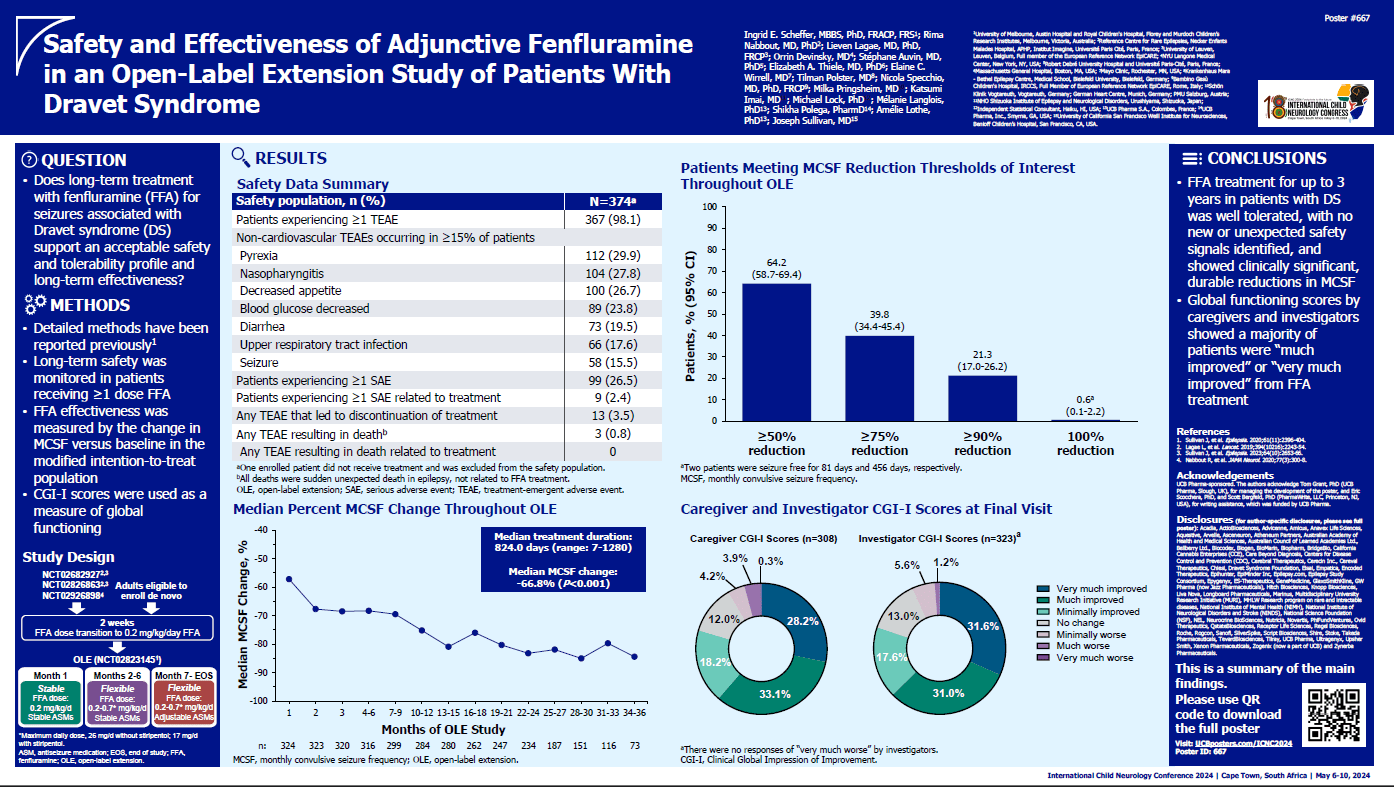Safety And Effectiveness Of Adjunctive Fenfluramine In An Open-Label Extension Study Of Patients With Dravet Syndrome
Introduction: Phase 3 and interim open-label extension (OLE) studies have shown profound, durable reductions in median monthly convulsive seizure frequency (MCSF) in patients with Dravet syndrome (DS) treated with fenfluramine (FFA). We report results from the final OLE analysis of FFA use in a large cohort of patients with DS.
Methods: Safety was reported for patients who received >=1 dose FFA. Key effectiveness endpoint in the modified intent-to-treat (mITT) group (from core study with baseline seizure frequency measured) was change in MCSF from core baseline vs overall OLE. Caregivers and investigators rated patients on the Clinical Global Impression-Improvement (CGI-I) scale. Descriptive statistics and Wilcoxon test for MCSF percent change from baseline were used.
Results: As of 27-Jan-2023, 375 patients had enrolled; 374 received >=1 dose FFA. Table 1 shows demographics and exposure. In the mITT population (n=324), median percent MCSF change from baseline over the entire OLE was -66.8%, P<0.001. At last visit, clinically meaningful improvement was reported by 61.4% and 62.5% of caregivers and investigators, respectively. No new or unexpected treatment-emergent adverse events were observed; there were no cases of valvular heart disease or pulmonary arterial hypertension. (Table 2)
Conclusion: This final analysis of patients with DS treated with FFA (median 2.3y) demonstrates sustained and clinically meaningful reduction in seizures and known safety profile. UCB Pharma-sponsored.
Ingrid E Scheffer
University of Melbourne, Austin Hospital and Royal Children's Hospital, Florey and Murdoch Children’s Research Institutes
Australia
Rima Nabbout
Reference Centre for Rare Epilepsies, Necker Enfants Malades Hospital, APHP, Institut Imagine, Université Paris Cité
France
Lieven Lagae
University of Leuven, Full member of the European Reference Network EpiCARE
Belgium
Orrin Devinsky
NYU Langone Medical Center
United States
Stéphane Auvin
Robert Debré University Hospital and Université Paris-Cité
France
Elizabeth A Thiele
Massachusetts General Hospital
United States
Elaine C Wirrell
Mayo Clinic
United States
Tilman Polster
Krankenhaus Mara - Bethel Epilepsy Centre, Medical School, Bielefeld University
Germany
Nicola Specchio
Bambino Gesù Children's Hospital, IRCCS, Full Member of European Reference Network EpiCARE
Italy
Milka Pringsheim
Schön Klinik Vogtareuth, PMU
Germany
Katsumi Imai
NHO Shizuoka Institute of Epilepsy and Neurological Disorders
Japan
Michael Lock
Independent Statistical Consultant
United States
Mélanie Langlois
UCB Pharma S.A.
France
Shikha Polega
UCB Pharma, Inc.
United States
Amélie Lothe
UCB Pharma S.A.
France
Joseph Sullivan
University of California San Francisco Weill Institute for Neurosciences, Benioff Children’s Hospital
United States

Lieven Lagae
University of Leuven, Full member of the European Reference Network EpiCARE
Belgium